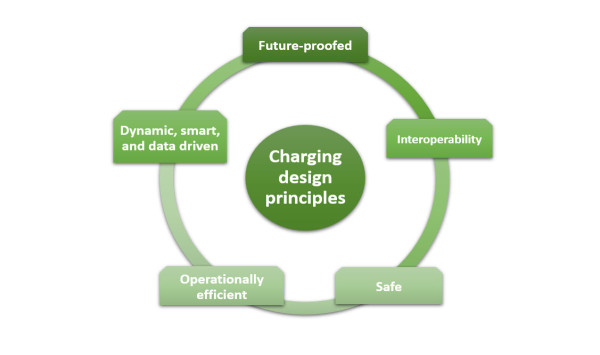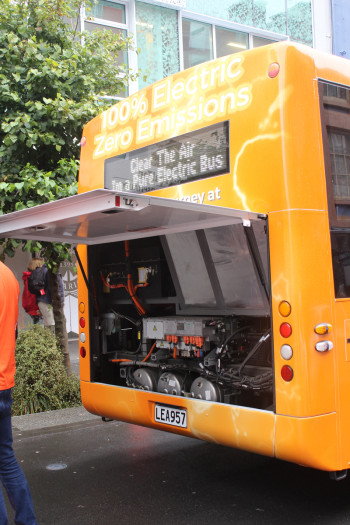|
This is draft guidance, and we welcome your feedback |

Charging design principles diagram.
Key overarching design principles that should guide the development of an electric bus network include:
Road to Zero 2020–2030, New Zealand’s road safety strategy, tells us all what we need to do to improve road safety. This strategy sets the country on a path to achieve Vision Zero – a New Zealand where no one is killed or seriously injured on the roads. The Road to Zero strategy sets an initial target to reduce deaths and serious injuries on New Zealand’s roads, streets, cycleways and footpaths by 40 percent over the 10 years to 2030 (from 2018 levels). Reaching that target would mean reducing annual road deaths to 227 and serious injuries to 1,680 by 2030. Improving safety on New Zealand roads is a Waka Kotahi priority, and this guidance is a part of our contribution to a safer transport network.
Road to Zero 2020–2030(external link)
The Battery electric bus charging topic is relevant to four focus areas under Road to Zero:
The deployment of low or zero emission buses in place of diesel buses reduces carbon emissions as well as air and noise pollution in urban areas. Public transport provides social and economic benefits such as enabling people to access jobs, schools, shops and other services, and has lower greenhouse gas emissions than driving.
Battery electric buses offer an excellent alternative to diesel buses, particularly because public transport vehicles typically return to a depot at the end of the day, which allows for overnight charging. Public transport buses also tend to run many hours a day compared to other vehicles, so electrifying buses can make an important contribution in decarbonising our transport system. In addition, Auckland trials indicated operating costs that were 70-85% lower than equivalent diesel bus services on the same route.
Public transport contracting authorities have begun encouraging the use of lower emission buses as part of their bus contracts. Battery electric buses have already been implemented on numerous routes in Auckland, Tauranga, Wellington, and Christchurch, with many public transport contracting authorities looking to accelerate their roll out. The government has announced a target of decarbonising the public transport fleet by 2035. Furthermore, the government has mandated that all new buses procured after 01 July 2025 must have zero emissions at the exhaust pipe.
Key benefits of battery electric buses for residents, public transport users, and bus operators compared to diesel buses are listed below:
|
Greenhouse gas emissions |
Battery electric buses have zero tailpipe emissions and will help New Zealand in the journey to be carbon neutral |
|
Air pollution |
Diesel buses emit pollutants including nitrogen and particulate matter which has been linked to respiratory and cardiovascular conditions. Buses tend to operate in concentrated areas (such as town and city centres) which exacerbates the air pollution issue. |
|
Reduced noise* |
Battery electric buses generate less noise and vibrations than diesel buses, making for a more pleasant journey for passengers and reduces noise pollution for residents and pedestrians along public transport routes. |
|
Lower maintenance costs |
Battery electric buses have less regular serviceable parts than those with internal combustion engines. Therefore, battery electric buses have lower maintenance costs than diesel buses. |
|
Lower fuel costs |
Battery electric buses have lower driving costs because, per kilometre, electricity is cheaper than diesel. Furthermore, battery electric buses are more energy efficient then internal combustion engines. |
*Note the quietness of e-buses may pose a safety issue for those in the street environment who have visual impairments so Acoustic Vehicle Alerting Systems should be considered. Note that parts of Australia are already planning to mandate this type of system.

Image of an electric bus with the display celebrating zero emissions. (Credit: Mark Edwards)
AS 2067 Substations and high voltage installations exceeding 1 kV a.c
AS 2550.1 Cranes, Hoists and Winches – Safe Use – General Requirements
AS 2676 Guide to the installation, maintenance, testing and replacement of secondary batteries in buildings sealed cells
AS 5062-2006 Fire protection for mobile and transportable equipment(external link)
AS/ACIF S009:2020 Installation requirements for customer cabling (wiring rules)
AS/NZS 1020 The control of undesirable static electricity
AS/NZS 1319 Safety signs for the occupational environment
AS/NZS 1418.10 Cranes, Hoists and Winches – Part 10: Mobile Elevating Work Platforms: Amendment 1:2017
AS/NZS 1657 Fixed platforms, walkways, stairways and ladders. Design, construction and installation
AS/NZS 1768 Lightning protection
AS/NZS 1891 Personal equipment for Work at Height, Part 1: Manufacturing requirements for full body combination and lower body harnesses
AS/NZS 2053 Conduits and fittings for electrical installations – General requirements
AS/NZS 2293.1 Emergency escape lighting and exit signs for buildings – Part 1: System design, installation, and operation
AS/NZS 2312 Guide to the protection of iron and steel against exterior atmospheric corrosion by the use of protective coatings – Part 1: Paint coatings
AS/NZS 3000 – AS/NZS 3000:2007 Electrical Installations (known as the wiring rules)
AS/NZS 3008.1.1 Electrical installations – Selection of cables – Part 1:1 cables for alternating voltages up to and including 0.6/1kV – Typical Australian installation conditions
AS/NZS 3012 Electrical Installations - Construction and demolition SitesAS/NZS 3017 Electrical installations – Verification guidelines
AS/NZS 3013 Electrical installations – Classification of the fire and mechanical performance of wiring systems
AS/NZS 3100 Approval and test specification – General requirements for electrical equipment
AS/NZS 3112 – AS/NZS 3112:2011 Approval and test specification – Plugs and socket-outlets
AS/NZS 3123 – AS/NZS 3123:2005 (R2016) Approval and test specification – Plugs, socket-outlets and couplers for general industrial application AS/NZS 3760 – AS/NZS 3760 In-service safety inspection and testing of electrical equipment, incorporating Amendments No. 1 and No. 2
AS/NZS 3820:2009 – AS/NZS 3820:2009 Essential safety requirements for electrical equipment
AS/NZS 4024 Safeguarding of machinery – Electrical equipment of machines – Part 1204: General requirements
AS/NZS 61439.1 Low-voltage switchgear and control gear assemblies – Part 1: General rules
CCM Communications Cabling Manual 2007 Vol.1 Handbooks, codes and regulations, Vol.2 Standards
IEC60309-1 – IEC60309-1 Plugs and socket-outlets and couplers for industrial purposes – Part 1: General requirements Edition 4.2
IEC60529 Degrees of protection provided by enclosures (IP Code)(external link)
IEC61439-7 – IEC61439-7:2018 Low-voltage switchgear and control gear assemblies – Part 7: Assemblies for specific applications such as marinas, camping sites, market squares, electric vehicle charging stations Edition 1.0 (or IEC TS 61439-7-2014)
IEC61851-1 – IEC61851-1:2017 Electric vehicle conductive charging system – Part 1: General requirements Edition 3.0 or, until 1 December 2020
IEC61851-22 – Until December 2020, IEC 651851-22:2001 Electric vehicle conductive charging system – Part 22: AC electric vehicle charging station Edition 1.0
IEC61851-23 – IEC61851-23:2014 Electric vehicle conductive charging system – Part 23: DC electric vehicle charging station Edition 1.0
IEC62196-1 – Plugs, socket-outlets, vehicle connectors and vehicle inlets – Conductive charging of electric vehicles – Part 1: General requirements Edition 3.0
IEC62262 – Degrees of protection provided by enclosures for electrical equipment against external mechanical impacts (IK code) Edition 1.0
ISO17409 – ISO17409:2015 Electrically propelled road vehicles – connection to an external electric power supply – Safety requirements
ISO15118 - Road vehicles – Vehicle to grid communication interface
M30 Specific Specification and Guidelines for Road Lighting Design [PDF, 806 KB]
SAEJ1772 – Standard for Electrical Connectors for Electric Vehicles maintained by SAE International
Standards New Zealand PAS 6010:2021(external link) provides a best practice guide for public and commercial electric vehicle charging with many of the same principles also applying to battery electric buses. We recommend that you read this in conjunction with this guidance.
UL2202 – Standard for Electric Vehicle (EV) Charging System Equipment Edition 2
UL2251 – Standard for Plugs, Receptacles, and Couplers for Electric Vehicles Edition 4
Find e-bus charging terms in the glossary section
Aamodt, A., Cory, K., Coney, K. (2021) “Electrifying transit: A guidebook for implementing battery electric buses(external link)”. National Renewable Energy Laboratory.
Bigelow, E. (2017). “Battery Electric Buses 101(external link).” Presented at the APTA Sustainability Workshop, Minneapolis, MN.
Bloomberg NEF. (2018). Electric Buses in Cities: Driving Towards Cleaner Air and Lower CO2(external link). (Accessed on 12 Oct. 2021)
Element Energy. (2018). A study of the impact of electrification of Auckland’s bus depots on the local electricity grid(external link).
Kostopoulos, E. D., Spyropoulos, G. C., Kaldellis, J.K. (2020) Real-world study for the optimal charging of electric vehicles(external link). Energy Reports. Volume 6, Pages 418-426.
Kunith, A., Mendelevitch, R., Kuschmierz, A. and Göhlich, D. (2016). Optimization of fast charging infrastructure for electric bus transportation – Electrification of a city bus network.
Odziomek M, Chaput F, Rutkowska A, Świerczek K, Olszewska D, Sitarz M, Lerouge F, Parola S. (2017) Hierarchically structured lithium titanate for ultrafast charging in long-life high capacity batteries(external link). Nature Communications. Volume 8, 15636.
Rogge, M, Wollny, S., and Sauer, D.U. (2015). "Fast Charging Battery Buses for the Electrification of Urban Public Transport—A Feasibility Study Focusing on Charging Infrastructure and Energy Storage Requirements"(external link) Energies 8, no. 5: 4587-4606. (Accessed on 12 Oct. 2021)
Te Manatu Waka Ministry of Transport. (2020). Public transport decarbonisation.
Transportation Research Board. (2021). Electric bus fire prevention and risk management(external link) (Research in Progress).
Trippe, A.E., Arunachala, R., Massier, T., Jossen, A. and Hamacher, T. (2014) "Charging optimization of battery electric vehicles including cycle battery aging," IEEE PES Innovative Smart Grid Technologies, Europe, 2014, pp. 1-6, doi: 10.1109/ISGTEurope.2014.7028735.
Vector (2016). New Zealand leads in global power revolution(external link). NZ Herald.
Waka Kotahi N Z Transport Agency (2022) Requirement for Urban Buses
Waka Kotahi N Z Transport Agency, Ministry of Transport (2016). Land Transport Rule: Vehicle Dimensions and Mass 2016
Zhang, L., Wang, S., Qu, X. (2021). “Optimal electric bus fleet scheduling considering battery degradation and non-linear charging profile"(external link). Transportation Research Part E: Logistics and Transportation Review. Volume 154.